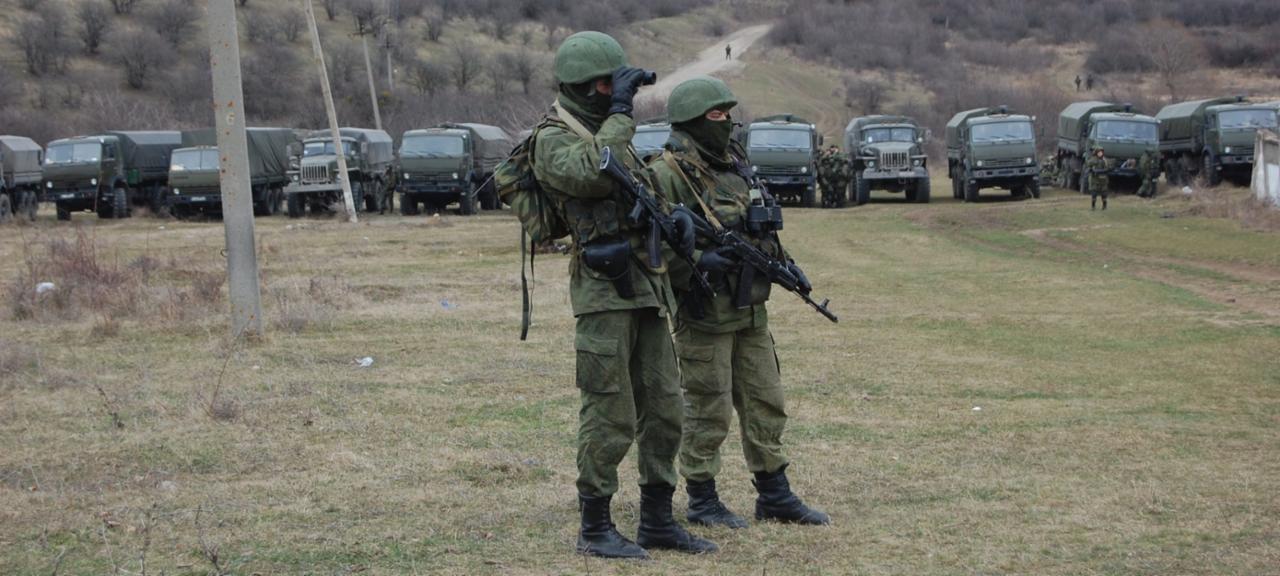One can argue that the nature of international security and conflicts remains the same. States are—as always—embroiled in zero-sum military and economic competitions, armed conflicts still seem inevitable, security dilemmas and balancing take place unremittingly, and so on and so forth. However, the modus operandi is no longer the same. Conflicts are fought in new, innovative, and radically different ways. With the advent of modern hybrid warfare, they are less and less about lethal or kinetic force.
It is important to note here that the concept of hybrid warfare might not be entirely new. Many practitioners contend that it is as old as war itself. Nevertheless, it has gained significant currency and relevance in recent years as states employ non-state actors and information technology to subdue their adversaries during or—more importantly—in the absence of a direct armed conflict.

Russian special forces in Crimea. Sometimes called “little green men”, they were one of the offensive “columns” that resulted in the illegal annexation of Crimea from Ukraine to Russia. @ Global Security Review
Before we delve into the concept, it is important to highlight that hybrid warfare in the contemporary era became increasingly popular in policy debates following two important developments. First, in 2005, two US military officials wrote about the “rise of hybrid wars” and emphasised the combination of conventional and unconventional strategies, methods, and tactics in contemporary warfare as well as the psychological or information-related aspects of modern conflicts. Second, Russia invaded Crimea in 2014 and achieved its objectives by virtue of conflating “deniable” special forces, local armed actors, economic clout, disinformation, and exploitation of socio-political polarisation in Ukraine.
Hybrid warfare remains a contested concept and there is no universally agreed definition of it. It has been subjected to a lot of criticism for lacking conceptual clarity, being merely a catch-all phrase or a buzzword, and not brining anything distinctly new to policy debates. Nevertheless, the concept furnishes us with key insights into contemporary and future security and defence challenges.
Hybrid Warfare and its Characteristics
To put it simply, hybrid warfare entails an interplay or fusion of conventional as well as unconventional instruments of power and tools of subversion. These instruments or tools are blended in a synchronised manner to exploit the vulnerabilities of an antagonist and achieve synergistic effects.
The objective of conflating kinetic tools and non-kinetic tactics is to inflict damage on a belligerent state in an optimal manner. Furthermore, there are two distinct characteristics of hybrid warfare. First, the line between war and peace time is rendered obscure. This means that it is hard to identify or discern the war threshold. War becomes elusive as it becomes difficult to operationalise it.
Hybrid warfare below the threshold of war or direct overt violence pays dividends despite being easier, cheaper, and less risky than kinetic operations. It is much more feasible to, let’s say, sponsor and fan disinformation in collaboration with non-state actors than it is to roll tanks into another country’s territory or scramble fighter jets into its airspace. The costs and risks are markedly less, but the damage is real. A key question here is: can there be a war without any direct combat or physical confrontation taking place? With hybrid warfare permeating inter-state conflicts, it is possible to answer this in the affirmative. This remains closely linked to the philosophy of war as well. The supreme art of war is to subdue the enemy without fighting, as the ancient military strategist, Sun Tzu, suggested.
The second defining characteristic of hybrid warfare relates to ambiguity and attribution. Hybrid attacks are generally marked by a lot of vagueness. Such obscurity is wittingly created and enlarged by the hybrid actors in order to complicate attribution as well as response. In other words, the country that is targeted is either not able to detect a hybrid attack or not able to attribute it to a state that might be perpetrating or sponsoring it. By exploiting the thresholds of detection and attribution, the hybrid actor makes it difficult for the targeted state to develop policy and strategic responses.
Grey Zone – The Complex Conflict Landscape
Recent studies on wars in Afghanistan and Iraq demonstrate how costly all-out wars can be in terms of human, economic, as well as social and political losses regardless of how disparate the capabilities of the conflicting parties or adversaries are. Owing to rapid technological advancements and the rise of asymmetric warfare, all-out wars can be ineffective even vis-à-vis powers that have relatively less resources and clout. Victory might thus become an extremely tough proposition.

Recent studies on wars in Afghanistan and Iraq demonstrate how costly all-out wars can be in terms of human, economic, and social and political losses, regardless of how disparate the capabilities of the conflicting parties or adversaries are. Owing to rapid technological advancements and the rise of asymmetric warfare, all-out wars can be ineffective even vis-à-vis powers that have relatively less resources and clout. Picture © The Journalist’s Review
With the cost of war ratcheting up and newer tools being at the disposal of states, the will to fight all-out wars might be diminishing. This, however, does not herald the waning of conflicts, but changes the dynamics of war. It is against this backdrop that states are increasingly resorting to hybrid warfare below the threshold of an armed conflict in pursuance of their zero-sum security goals. In a nutshell, the overall security environment is radically changing despite the nature of conflict remaining the same.
“War is nothing more than the continuation of politics by other means,” the eminent military strategist Clausewitz said. While this might still be true, the means of war have expanded remarkably amidst the advent of contemporary hybrid warfare. This means that the politics-war matrix has become even more complex, since the dynamics of war are in a state of flux. War now means a range of possibilities. Sometimes, it might entail kinetic operations in conjunction with the use of non-state actors. Sometimes, it might involve launching cyberattacks targeting critical infrastructure together with disinformation campaigns. Such avenues are extensive and so are the ways in which they may be fused or juxtaposed.
Hybrid warfare makes conflict dynamics murky not only because it offers a large and expanding toolkit to undermine an adversary but also because it allows its security to be undercut on two fronts in tandem. This also relates to the overarching objectives of hybrid warfare. On the capability front, the vulnerabilities of the targeted state in the political, military, economic, social, information, and infrastructure (PMESII) realms are exploited insofar as it is tangibly and functionally weakened.
A second front on which a state’s security is undermined remains ideational in nature and relates to the legitimacy of the state. As a Norwegian Agency for Development Cooperation report notes, “state legitimacy concerns the very basis on which state and society are linked and by which state authority is justified.” Thus, legitimacy intrinsically serves as the bedrock of the authority or the writ of the state.
In a bid to impair the social contract that binds the state and its constituents together, a hybrid actor attempts to erode trust between the state institutions and the people. This results in the state losing its legitimacy—which is largely a function of public trust in the modern era—and, in turn, the capacity to act as the Leviathan in the domestic sphere. As a corollary, both the ideational foundations as well as the capacity of the state to function seamlessly are damaged through hybrid attacks.
Building Trust to Surmount Hybrid Threats
Considering the complex nature and dynamics of hybrid warfare, a range of policy and strategic responses have been propounded by experts. Some of these revolve around measures for detecting, deterring, countering, and responding to hybrid threats in a meticulous manner. Nevertheless, with the information, cognitive and social domains becoming the cornerstone of hybrid warfare, any set of solutions sans confidence-and trust-building will probably fall short of offering effective antidotes.
We have already discussed that hybrid warfare often takes place below the traditional threshold of war. What takes the centre stage here is the role of civilians: how they think and act in relation to the state. Contemporary digital and social media platforms allow hybrid actors to influence this to the detriment of the adversary state with considerable ease. The Russian online disinformation campaigns, some of which are very subtle yet grave, against some Western states constitute a good case in point.

Contemporary digital and social media platforms allow hybrid actors to influence the role of civilians: how they think and act in relation to the state. Picture © Brookings Institution
Also, as alluded to earlier, the state is spineless without the people. It draws legitimacy and, by the same token, power from its people. This applies especially to polities that are democratically structured. By driving a wedge between the state and its people, one can create conditions for its implosion. This is precisely what a hybrid actor aims at doing below the war threshold.
Hybrid threats are often tailored to the vulnerabilities of the target state or inter-state political communities. The purpose is to exploit them insofar as they are deepened to create and exacerbate polarisation both at the national and international levels. This translates into perilous erosion of the core values of coexistence, harmony, and pluralism in and amongst democratic societies as well as the decision-making capability of the political leaders. Ultimately, what hybrid threats undercut is trust.
It is for this reason that building trust must be deemed the key bulwark against hybrid threats, especially ones that are geared towards undermining democratic states and polities. Moreover, trust remains the sine qua non for any policy or strategic response to hybrid threats to come to fruition. In other words, nothing will work or produce the desired results in the absence of trust.
Trust must not be understood as a single-layered or unidimensional phenomenon. It is needed on several levels and multiple domains. For instance, people must have confidence in the state organs for governments to ensure compliance with their decisions. It is alarming that in a lot of Western countries as evidence suggests - state institutions are losing their credibility owing to diminishing public trust. In the United States, public trust has declined from 73 percent in the 1950s to 24 percent in 2021. Similarly, in Western Europe, trust levels have been steadily declining since the 1970s.
It is not just public trust in the state that is paramount. People’s trust in each other remains equally important. The rise of populism in different parts of the world—including the Western countries—is symptomatic of greater socio-political polarisation within political communities. This results in jeopardising not only harmony at the societal level but also a community’s social and political fabric, thereby making it difficult to develop consensus in decision-making processes on all levels.
Building, re-building, and fortifying trust remains critical to creating durable resilience in the face of hybrid threats that acutely imperil the security at the state and societal levels. Trust-building within and across communities ought to be the linchpin of efforts to neutralise hybrid warfare and threats. This requires sustained efforts at the structural and policy levels to develop strong links between the state and the people that are underpinned by meaningful transparency, ownership, and inclusiveness.
This is the first article in a mini-series on “the grey zone” which focuses on hybrid threats, warfare and defence.
